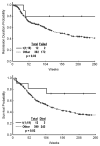Adults with acute lymphoblastic leukemia and translocation (1;19) abnormality have a favorable outcome with hyperfractionated cyclophosphamide, vincristine, doxorubicin, and dexamethasone alternating with methotrexate and high-dose cytarabine chemotherapy
- PMID: 19298009
- PMCID: PMC4199455
- DOI: 10.1002/cncr.24266
Adults with acute lymphoblastic leukemia and translocation (1;19) abnormality have a favorable outcome with hyperfractionated cyclophosphamide, vincristine, doxorubicin, and dexamethasone alternating with methotrexate and high-dose cytarabine chemotherapy
Abstract
Background: Among the well described cytogenetic abnormalities in adults with acute lymphoblastic leukemia (ALL), a translocation involving chromosomes 1 and 19 (t[1;19] [q23;p13]) occurs in a small subset but has been associated variously with an intermediate prognosis or a bad prognosis in different studies.
Methods: Adults with ALL and t(1;19) who were treated at The University of Texas M. D. Anderson Cancer Center were reviewed. Their clinical features and outcomes were compared with those of patients who had other cytogenetic abnormalities. The study endpoints included the complete remission (CR) rate, the complete response duration (CRD), and overall survival (OS).
Results: Of 411 adults with pre-B-cell ALL, 12 patients had t(1;19). Ten of 12 patients with t(1;19) received hyperfractionated cyclophosphamide, vincristine, doxorubicin (Adriamycin), and dexamethasone alternating with methotrexate and high-dose cytarabine (hyper-CVAD) chemotherapy; and the other 2 patients received combined vincristine, doxorubicin, and dexamethasone (VAD). All 12 patients achieved CR, and the 3-year survival rate was 73%. Patients with t(1;19) had significantly better CRD and OS compared with all other patients combined and compared individually with patients who had Philadelphia chromosome-positive, t(4;11), and lymphoma-like abnormalities (deletion 6q, addition q14q, t[11;14], and t[14;18]).
Conclusions: Adults with ALL and t(1;19) had an excellent prognosis when the received the hyper-CVAD regimen.
Conflict of interest statement
The authors made no disclosures.
Figures



Similar articles
-
Relation between the duration of remission and hyperglycemia during induction chemotherapy for acute lymphocytic leukemia with a hyperfractionated cyclophosphamide, vincristine, doxorubicin, and dexamethasone/methotrexate-cytarabine regimen.Cancer. 2004 Mar 15;100(6):1179-85. doi: 10.1002/cncr.20071. Cancer. 2004. PMID: 15022284
-
Anthracycline dose intensification in adult acute lymphoblastic leukemia: lack of benefit in the context of the fractionated cyclophosphamide, vincristine, doxorubicin, and dexamethasone regimen.Cancer. 2010 Oct 1;116(19):4580-9. doi: 10.1002/cncr.25319. Cancer. 2010. PMID: 20572037 Free PMC article.
-
Long-term follow-up results of hyperfractionated cyclophosphamide, vincristine, doxorubicin, and dexamethasone (Hyper-CVAD), a dose-intensive regimen, in adult acute lymphocytic leukemia.Cancer. 2004 Dec 15;101(12):2788-801. doi: 10.1002/cncr.20668. Cancer. 2004. PMID: 15481055 Clinical Trial.
-
The hyper-CVAD regimen in adult acute lymphocytic leukemia.Hematol Oncol Clin North Am. 2000 Dec;14(6):1381-96, x-xi. doi: 10.1016/s0889-8588(05)70192-1. Hematol Oncol Clin North Am. 2000. PMID: 11147229 Review.
-
The Efficacy of Pediatric-Inspired Regimens vs. Hyper-CVAD in the Treatment of Adolescents and Young Adults With Acute Lymphoblastic Leukemia: A Systematic Review and Meta-Analysis.Am J Hematol. 2025 May;100(5):847-859. doi: 10.1002/ajh.27607. Epub 2025 Feb 13. Am J Hematol. 2025. PMID: 39945071 Free PMC article.
Cited by
-
Current Role of Genetics in Hematologic Malignancies.Indian J Hematol Blood Transfus. 2016 Mar;32(1):18-31. doi: 10.1007/s12288-015-0584-4. Epub 2015 Sep 16. Indian J Hematol Blood Transfus. 2016. PMID: 26855503 Free PMC article. Review.
-
Recent Advances in Adult Acute Lymphoblastic Leukemia.Curr Hematol Malig Rep. 2019 Apr;14(2):106-118. doi: 10.1007/s11899-019-00503-1. Curr Hematol Malig Rep. 2019. PMID: 30879177 Review.
-
A (1;19) translocation involving TCF3-PBX1 fusion within the context of a hyperdiploid karyotype in adult B-ALL: a case report and review of the literature.Biomark Res. 2015 Feb 18;3:4. doi: 10.1186/s40364-015-0029-0. eCollection 2015. Biomark Res. 2015. PMID: 25729575 Free PMC article.
-
Certainty in uncertainty: Determining the rate and reasons for reclassification of variants of uncertain significance in haematological malignancies.EJHaem. 2024 Sep 12;5(5):957-963. doi: 10.1002/jha2.1002. eCollection 2024 Oct. EJHaem. 2024. PMID: 39415915 Free PMC article.
-
Molecular Detection of Fusion Oncogenes in Zambian Patients with Acute Lymphoblastic Leukemia.Int J Appl Basic Med Res. 2020 Oct-Dec;10(4):234-239. doi: 10.4103/ijabmr.IJABMR_179_19. Epub 2020 Oct 7. Int J Appl Basic Med Res. 2020. PMID: 33376695 Free PMC article.
References
-
- Larson RA, Dodge RK, Bloomfield CD, Schiffer CA. Treatment of biologically determined subsets of acute lymphoblastic leukemia in adults: Cancer and Leukemia Group B studies. In: Buchner T, Hiddeman W, Wormann B, et al., editors. Acute Leukemias VI: Prognostic Factors and Treatment Strategies. Berlin: Springer-Verlag; 1997. pp. 677–686.
-
- Bloomfield CD, Goldman AI, Alimena G, et al. Chromosomal abnormalities identify high-risk and low-risk patients with ALL. Blood. 1986;67:415–420. - PubMed
-
- Shurtleff SA, Buijs A, Behm FG, et al. TEL/AML1 fusion resulting from a cryptic t(12;21) is the most common genetic lesion in pediatric ALL and defines a subgroup of patients with excellent prognosis. Leukemia. 1995;9:1985–1989. - PubMed
-
- McLean TW, Ringold S, Neuberg D, et al. TEL/AML-1 dimerizes and is associated with a favorable outcome in childhood ALL. Blood. 1996;88:4252–4258. - PubMed
-
- Ribeiro RC, Abromowitch M, Raimondi SC, et al. Clinical and biologic hallmarks of the Philadelphia chromosome in childhood ALL. Blood. 1987;70:948–953. - PubMed
MeSH terms
Substances
Supplementary concepts
Grants and funding
LinkOut - more resources
Full Text Sources
Research Materials

